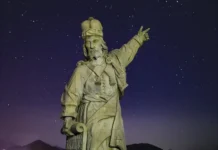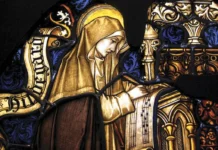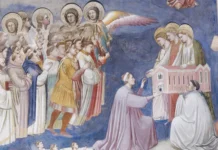History is made by providential men who, by their fidelity
to the divine plan, determine the destiny of entire civilizations. The monastic scribes are an edifying example of this.
There were no computers, no photocopiers, not even the old fashioned typewriters. The printing press did not yet exist. Nevertheless, medieval man was able to transmit to Western Civilization the entire and immense cultural and philosophical legacy of the Greek and Roman civilizations—literary works and manuscripts from a world that ceased to exist, destroyed by the barbarian invasions at the end of the Ancient Era. How was such a feat accomplished without the help of printing techniques invented and developed centuries later?
The answer to this question lies in the monasteries and abbeys of the Catholic Church (the only institution that resisted the attacks of the barbarian hordes), which, in addition to playing a prominent role in the cultural, moral and religious formation of society, safeguarded, among others, the writings of Greek and Latin authors, including Aristotle and Herodotus, Cicero and Virgil, St. Augustine and Boetius, not counting the manuscripts of the New Testament, reproducing them through patient, painstaking and organized work.
This was the mammoth task of an assemblage of unassuming monastic scribes, whose names history has forgotten. How did they arise? And what was the importance of their work for the progress of Western Civilization?

A world in upheaval
The transition from the classical world to the Middle Ages occurred with the fall of the Western Roman Empire (476 AD) and the intensification of the barbarian invasions in Europe, which provoked chaos and destruction in what remained of civilization.
The conversion of Clovis and the Franks, in the year 496, marked the beginning of a process of Christianization that would take another four centuries to complete in Western Europe. With the adhesion of the people to Christianity, progress could gradually be seen throughout society, not only in the spiritual realm, but in all fields of human endeavour, giving rise to the blossoming of Christian Civilization.
However, peace was far from reigning in Europe, because hordes of barbarians continued to ravage everything that lay in their path. “They destroyed human lives, monuments and economic inventory,” resulting in “demographic decline, the loss of artistic treasures, the ruin of roads, ateliers, storehouses, irrigation systems and agriculture.”1 Not even libraries and collections of texts were spared from this massive devastation.
At this dramatic crossroads of history, the cloisters of the monasteries served as an ideal refuge for the writings and documents of great historical and cultural importance. In this undertaking Vivarium Monastery, and the Benedictine and Irish monks stood out, as we will see.
“Vivarium” Monastery
The history of this monastery began with Cassiodorus, who occupied the office equivalent to that of prime minister (magister officiorum) for Theodoric the Great (454-526), king of the Eastern Goths and Ostrogoths, regent of the Visigoths and governor of the Italian peninsula. With the reign of the Goths seriously compromised, Cassiodorus withdrew from public life at age 65. Moved by divine inspiration, and certainly by the example of St. Benedict of Nursia, who had recently founded the monastery of Monte Cassino, he decided to found a monastery on lands belonging to his family, in the vicinity of Squillace, in southern Italy.
Vivarium, as it was called, is at the root of the great spiritual and intellectual adventure of Cassiodorus, because it was there that he wrote several works of a theological and philosophical nature, in addition to a book expounding the rules for transcribing manuscripts.
However, his greatest contribution to civilization was not his writings, but the crucial fostering of culture and education in that difficult period of transition. He formed a theological school, organized a library endowed with many Greek manuscripts brought from Constantinople, and established a scriptorium (part of the monastery set aside for the work of copying texts). In this place the religious compiled and translated the Bible, the Fathers of the Church and the pagan authors of Antiquity, both Latin and Greek.2

According to tradition, this was the first scriptorium of history, and it was also there that, for the first time, scientific work was explicitly included among the monks’ persuits.3 Furthermore, the abbot of Vivarium, who was a gifted orator, dedicated himself to teaching and, according to some authors, anticipated in several aspects the great medieval institution of the university, which emerged about six hundred years later. With good reason he is called champion and restorer of learning in the sixth century.4 His commitment and persistence were not only important for the copies of the text themselves, but also for the method of transmission of the manuscripts and culture in general.
The texts would reach him, in part, through the Fathers of the Church. Both their writings as well as those of earliest monasticism were appropriately separated from the intellectual output of paganism, stigmatizing the latter and giving preference to Sacred Scripture. It was an attitude aimed at protecting the faithful from errors in the first centuries of the Church. However, some Catholic authors of that time, among whom St. Clement of Alexandria and St. Gregory Nazianzen are noteworthy, in an ironic twist of fate, became unwitting transmitters of the doctrine of several ancient thinkers: to refute the errors of pagan thought it was necessary to know it. This is why they kept the works of these writers in their libraries.
Cassiodorus, for his part, selected certain classical texts to be copied. According to him, these could bolster biblical studies with scientific support, even if from profane authors. With this goal, he wrote Institutions, an encyclopaedic guide dedicated to the conciliation of the Bible with the classical legacy. So that the transcribing of certain authors would not pose a threat to the orthodoxy of his monks, instead of simply eliminating some works, the founder of Vivarium placed a warning note on the questionable passages.5
In this way, in the final decades of his almost century-long life, Cassiodorus was a great methodical organizer of culture in the West, of Hellenic, Roman and Christian tradition, opening the doors for this massive intellectual achievement within the heart of monasteries. Despite the fact that the Vivarium only survived for about twenty years after the death of its founder, its manuscripts for the most part were preserved. According to scholars, they were probably sent to the Lateranense Library in Rome and various Benedictine monasteries, such as Bobbio, established by Irish monks. However, the adventure of the manuscripts in the West was just beginning…

The Benedictines
Another milestone in the history of manuscript transmission during this period was the founding of the Benedictines by St. Benedict of Nursia (480-547).
Contrary to Cassiodorus, he entered religious life at a young age. At the behest of his family, he spent some time in Rome to complete his studies, and witnessed the extreme corruption and moral decadence in the great metropolis. Some years later, he received a special grace that inspired him to take the firm resolution to dedicate himself to the hermetic life in an austere grotto in Subiaco. Inspired by his example, several other men who desired to follow the same way of perfection joined him. Thus, in a short time twelve monasteries were founded in the vicinity of Sacro Speco, with twelve monks in each. One of them still exists, today called St. Scholastica. In 529, he established the famous Monastery of Monte Cassino, reference point for monastic and cultural life throughout Europe.
Subsequently, the holy founder introduced the well-known maxim “ora et labora” and his famous Rule. This was disseminated throughout all of Western Christianity to the point of being taken as the model not only for monastic life, but for all of medieval society. It did not contain a specific precept for the work of copying manuscripts, as Cassiodorus had prescribed, yet its effects on manuscript transmission were even greater for subsequent centuries than those of the fleeting life of the Vivarium.6
According to chapter 48 of the Rule, monks should dedicate a certain amount of time to reading: “Idleness is the enemy of the soul. Therefore the brothers should be occupied at certain times in manual labour, and again at fixed hours in sacred reading.” But how could this be done without books to read? Implicitly, then, the principles of St. Benedict favoured manuscript tradition.7
The expansion of this tradition grew from the success of the Benedictines, but not without difficulties. To copy a work was undoubtedly a monotonous and protracted task. Suffice it to say that it took two or three months to copy a manuscript of medium size. It is not unusual to find descriptions in the colophons8 of the hardships that the amanuenses endured, whether because of discomfort—at times writing while kneeling—, or due to the lack of heating and adequate light in winter. Also registered in the colophons are interesting expressions of the authentic medieval spirit: in some there are requests for prayers for the copyist “whose name is written in the Book of Life”; in others, more inspired, poems or acrostics are inscribed in honour of Jesus and Mary; and finally there were scribes who imputed an anathema in the colophon against anyone who dared to steal so costly a manuscript…
To these difficulties were added the high cost of parchments. For this reason, in the seventh and eighth centuries, certain texts of lesser interest were erased or scraped away to make way for others in greater demand. The scribes wrote over the text that had been removed. This type of manuscript came to be called palimpsest (from the Greek πάλιν and ψάω, “again” and “I scrape”). Today, sophisticated recovery techniques allow the “erased” marks of the manuscripts to be detected, revealing to us, at times, unpublished texts. In this way, those monks, without knowing it, were preserving two or even more texts simultaneously, on the same parchment.

By the eleventh century there was great progress in the art of copying. Among the Benedictines, particularly noteworthy is the work of the abbot Desiderius, who promoted the great cultural revival of Monte Cassino.9 The author Thomas Woods aptly summarizes this Benedictine rebirth, stating that Desiderius “described as the greatest of the abbots of Monte Cassino after Benedict himself and who became Pope (Blessed) Victor III in 1086, specifically oversaw the transcription of Horace and Seneca, as well as Cicero’s De Natura Deorum and Ovid’s Fasti.”10 Another monk from the same monastery and a friend of Victor III, Archbishop Alfano, “possessed a similar fluency in the works of the ancient writers, frequently quoting from Apuleius, Aristotle, Cicero, Plato, Varro, and Virgil, and imitating Ovid and Horace in his verse.”11 Also worthy of mention is St. Anselm, who “while abbot of Bec, commended Virgil and other classical writers to his students, though he wished them to put aside morally objectionable passages.”12
Therefore it was “the monks of Cassiodorus and St. Benedict that gave the ‘copy’ for the first editions of Cicero, Virgil, and the other classical writers, produced by the earliest printers of Germany and Italy.”13 Still to come were the Irish monks, who gave a special impetus to written cultural transmission.
The Irish monks
God always raises up providential men for each historical epoch. At the same time that St. Benedict left this world, St. Columbanus, our final protagonist, was born in Ireland.
He came into the world around the year 543 in the province of Leinster, Ireland. After spending almost 25 years as a monk in his native country, he felt a calling by God to preach the Gospel in foreign lands. With twelve companions he set out for Gaul (present day France) and founded important monasteries in Annegray, Fontaines and Luxeuil, where he wrote a Rule, the Regula monachorum. Under the impulse of this latter monastery close to two hundred others were established.
Sometime later, for having reprimanded the concubinage of King Theodoric, Columbanus was obliged to leave Gaul, condemned to exile in Ireland.

However, for some unexplainable reason, the ship ran aground a short distance from the beach and the captain, seeing this as a sign from heaven, refused to proceed and, out of fear of being cursed by God, returned the religious to shore. Nevertheless, the Irish saint, instead of returning to Luxeuil, decided to start a new work of evangelization. He headed for Germany, passing through Switzerland, where he left a disciple called Gallus, who founded the important abbey of St. Gall there. St. Columbanus finally arrived to Lombardy, Italy, where he founded the famous Bobbio Monastery, source of spiritual and intellectual vigour in that era, to such a degree that it was known as the Monte Cassino of northern Italy.
St. Columbanus and his Irish monks were considered one of the great instruments for the salvation of civilization. This is the opinion of Thomas Cahill, stated in the book How the Irish Saved Civilization.14 This work spent two years on the New York Times bestseller list, reaching second place, and was translated into several languages, with a total of more than 1.25 million copies printed. His thesis, considered controversial by some critics, is essentially that the Irish, and monks in particular, in fact saved civilization from the destruction resulting from barbarism. St. Patrick (389-461?) took the first step, encouraging studies and the education of monks, and also the laity. St. Columbanus complemented his work of fostering culture. His work took on great proportions in forming another vanguard of monastic scribes at the beginning of the High Middle Ages.
However, according to Cahill, the monks of Columbanus possessed certain peculiarities—they were especially persistent and copied any and every work that fell into their hands.15 As a result, Bobbio Abbey came to possess the largest collection in the West. A ninth century catalogue bears witness to its extraordinary wealth: even at that time it possessed a collection of between six and seven hundred titles, from sacred and classical authors including: Terence, Lucretius, Virgil, Horace, Persius, Juvenal, Martial, Ovid, Valerius, Flaccus, Claudian, Ausonius, Cicero, Seneca and Pliny.16
Additionally, copies of some of the oldest extant Latin manuscripts are the product of Bobbio Abbey. These relics reveal not only the literary value, but also the artistic importance of the manuscripts produced by the Irish monks and their disciples. Especially outstanding in the illumination are the detailed and decorative first letters and a typical style of calligraphy that influenced many monasteries. The illustrations were veritable treasures and were often coloured with gold and lapis-lazuli, and several other resources.
Musical tradition was also the object of their work. Psalms, antiphons, sequences, graduals and all types of liturgical codices — breviaries, lectionaries, martyrologies, missals, etc. — attest to the vast cultural education of the monks.17 In the aforementioned monastery of St. Gall a neume notation system for Gregorian chant emerged which enabled the preservation of the melodic tradition in written form, influencing a great part of Central and Eastern Europe.18 This system, preserved by the Codex Sangallensis 359, written between 922-925, is still the standard for interpretation of Gregorian Chant semiology.
Example of wisdom, perseverance and asceticism
In view of this scenario, referring to the monastic scribes, O’Connor categorically affirms: “Had it not been for their intelligent and untiring efforts Greek and Latin literature would have disappeared as completely as the literature of Babylonia and Phoenicia.”19 The cultural destiny of the Western world depended on the generous commitment of a few individuals, true anonymous heroes.

Gradually, especially with the creation of universities in the twelfth century, the manuscript tradition transcended the scriptorium of the monasteries to all classes of society: secular clergy, nuns, notaries, professional scribes, professors, students, etc.20 However, by that time the transmission of texts had already been safeguarded. An uplifted Europe had overcome the difficulties of the transition from the classical to the medieval world.
Therefore, in addition to transmitting texts—which is in itself something extraordinary—the monks gave us the example of wisdom, perseverance and asceticism, by bequeathing the Christian and classical cultural tradition to subsequent centuries. It is impossible to accurately calculate the mammoth consequences of this diligent undertaking. Nor can we surmise what would have become of today’s Western culture if these monks had, for example, been exterminated by the barbarian hordes or had simply become discouraged at that crucial moment. What is certain is that the destiny of Western Civilization passed through their hands. ◊
Notes







